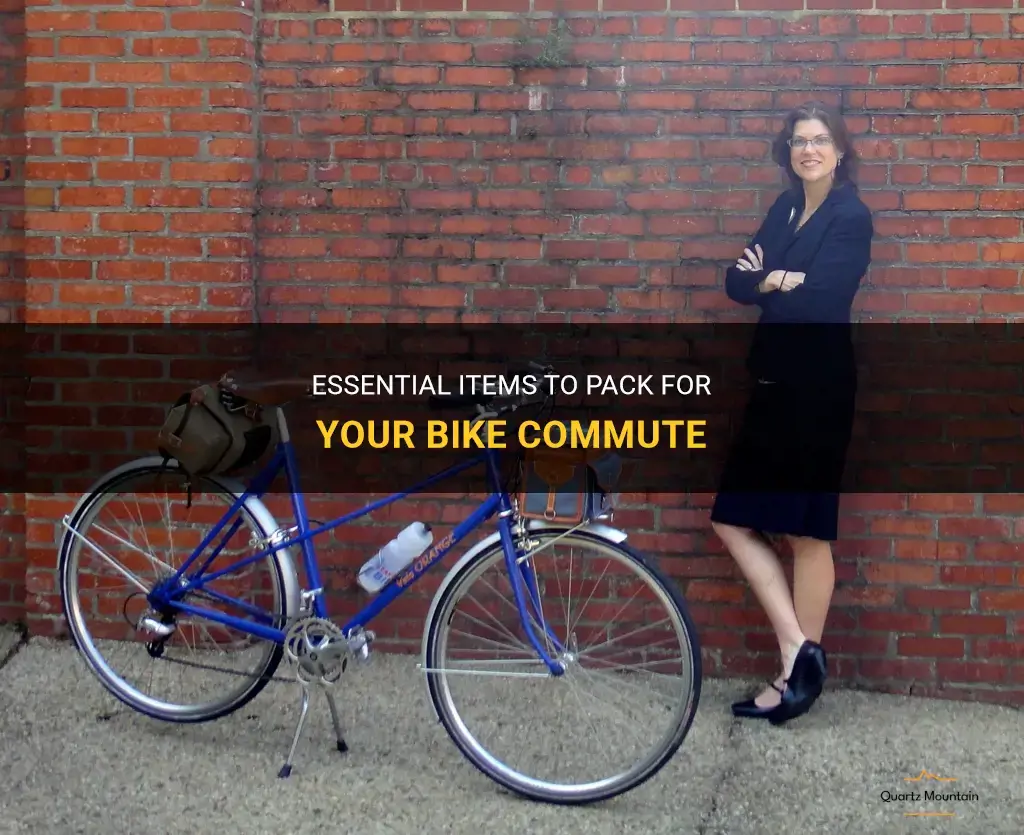
Are you tired of sitting in traffic every day on your way to work? Why not ditch the car and start biking instead? Not only is biking a great form of exercise, but it can also save you time and money. But before you embark on your bike commute, it's important to pack the essentials to ensure a smooth and enjoyable ride. In this article, we will discuss the must-have items to pack for your bike commute. So grab your helmet and let's get started!
| Characteristics | Values |
|---|---|
| Clothing | Helmet, reflective clothing |
| Bag | Backpack, panniers |
| Tools | Bike lock, tire repair kit |
| Accessories | Lights, bell, mirror |
| Hydration | Water bottle, hydration pack |
| Spare parts | Inner tubes, pump, multitool |
| Electronics | Phone mount, cycling computer |
| Weather | Rain jacket, sun protection |
| Comfort | Padded shorts, gloves |
| Safety | Reflective tape, front and rear lights |
What You'll Learn
- What are the essential items to pack for a bike commute?
- How do you pack clothing for a bike commute to ensure they stay wrinkle-free?
- Are there any specific tools or repair items that should be included in a bike commute pack?
- What are some tips for packing light for a bike commute without sacrificing necessary items?
- Are there any safety equipment or gear that should be packed for a bike commute?

What are the essential items to pack for a bike commute?
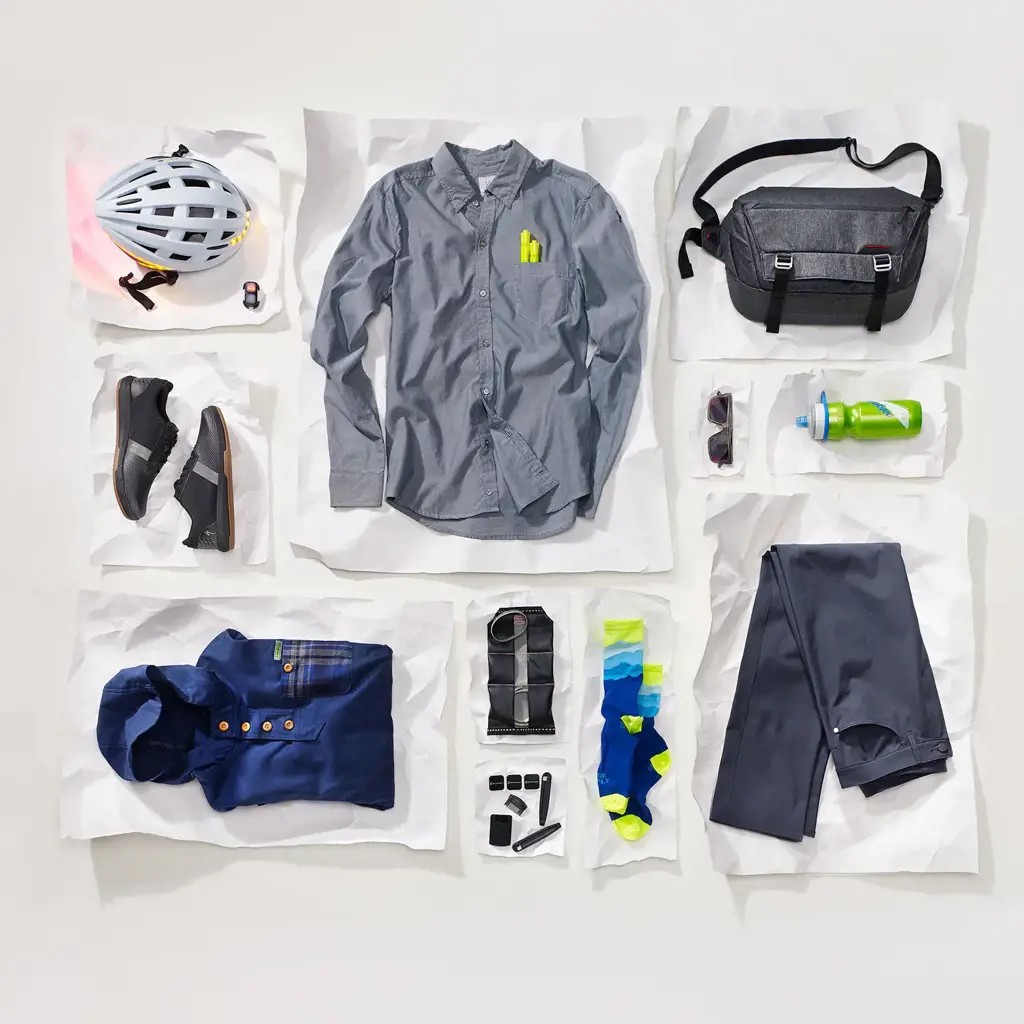
Commuting by bike has become increasingly popular in recent years, as more people are looking for eco-friendly and efficient ways to travel. Whether you are a seasoned bike commuter or just starting out, there are a few essential items that you should always pack to ensure a smooth and safe ride.
- Helmet: This goes without saying, but a helmet is the most important piece of safety equipment you can wear while biking. Make sure your helmet fits properly and is in good condition.
- Bike lock: Unless you have a secure indoor space to park your bike, a sturdy bike lock is a must-have. Look for a lock that is both strong and easy to use.
- Lights: If you are commuting during the early morning or evening hours, it is crucial to have lights on your bike. Front and rear lights will make you more visible to other road users and help you see the road ahead.
- Reflective gear: Wearing reflective clothing or accessories is another way to increase your visibility on the road. Invest in a reflective vest or jacket, as well as reflective ankle straps or stickers to make sure you are seen by motorists.
- Repair kit: Flat tires happen, so it's important to be prepared. Pack a small repair kit with a spare tube, tire levers, and a portable pump. Familiarize yourself with how to fix a flat tire before you hit the road.
- Water bottle: Staying hydrated is essential, especially on longer commutes. Invest in a good quality water bottle and make sure to fill it up before you leave.
- Snacks: Depending on the length of your commute, you may want to pack a small snack to keep your energy levels up. Granola bars, dried fruit, or nuts are all great options.
- Rain gear: Don't let a little rain stop you from riding to work. Invest in a lightweight, breathable rain jacket and pants to stay dry and comfortable.
- Personal identification: In case of an emergency, it's always a good idea to carry some form of identification with you. A driver's license or a medical identification card will suffice.
- Basic first aid kit: While accidents are rare, it's better to be prepared. Pack a small first aid kit with band-aids, antiseptic wipes, and any necessary medications.
- Cell phone: In case of an emergency or if you need to call for assistance, always carry your cell phone with you. Make sure it is fully charged before you start your ride.
- Route planning: Before you set off, plan your route and have a general idea of where you are going. Consider using a GPS device or a bike-friendly map app to help you navigate.
Remember, these are just the essentials. Depending on your specific needs and preferences, you may want to pack additional items like a change of clothes, a towel, or extra bike tools. The key is to be prepared and make sure you have everything you need for a safe and enjoyable bike commute.
Essential Items to Pack in Your Diaper Bag for Every Outing
You may want to see also

How do you pack clothing for a bike commute to ensure they stay wrinkle-free?
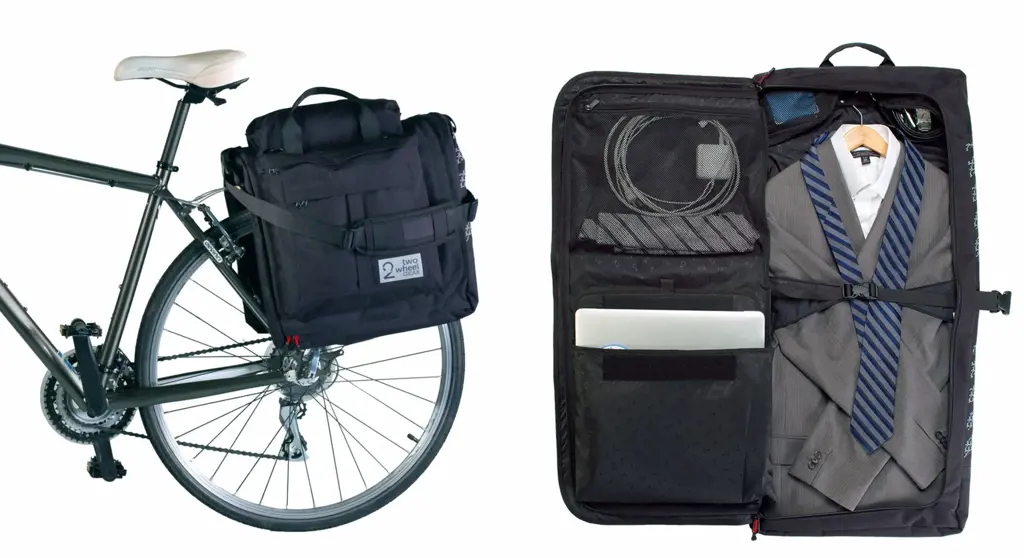
Whether you are biking to work or simply going on a bike ride, it can be a challenge to pack your clothing in a way that ensures they stay wrinkle-free. However, with a few simple tips and tricks, you can easily pack your clothes and keep them looking neat and crisp.
Here are some steps to help you pack your clothing for a bike commute and ensure they stay wrinkle-free:
- Choose the right fabric: When it comes to packing clothes for a bike commute, choosing the right fabric is crucial. Opt for wrinkle-resistant fabrics such as polyester, nylon, or spandex blends. These materials are more likely to stay wrinkle-free, even after being packed tightly in a backpack.
- Fold your clothes properly: Proper folding is essential to minimize wrinkles. Start by buttoning up shirts and jackets to keep them in shape. Lay the garment flat on a clean surface and fold in the sides to create a clean, even fold. Then, fold the garment in half, lengthwise, and roll it tightly from the bottom to the top. This rolling method not only prevents wrinkles but also saves space in your bag.
- Use packing cubes or garment bags: Packing cubes or garment bags can be a lifesaver when it comes to organizing and protecting your clothes. Place your folded clothes inside the packing cubes or garment bags, making sure there is enough space to prevent squishing. These bags provide an extra layer of protection and help keep your clothes wrinkle-free during your bike commute.
- Pack clothes separately from other items: To prevent wrinkles caused by other items shifting in your bag, it is essential to pack your clothes separately from other belongings. If possible, dedicate a separate compartment or bag solely for your clothes. This will minimize the chances of your clothes getting wrinkled or crushed by other items.
- Consider rolling instead of folding: If you are short on space or have delicate fabrics, rolling your clothes can be a better option than folding. This method helps reduce wrinkles by eliminating the creases created by folding. Roll each garment tightly, starting from one end to the other. Place the rolled clothes side by side in your bag, creating a compact and wrinkle-resistant bundle.
- Hang clothes upon arrival: Once you have reached your destination, promptly hang up your clothes to prevent any lingering wrinkles. If you have access to a garment steamer, you can quickly remove any minor wrinkles that may have developed during your bike commute. If not, hanging your clothes can help them naturally smooth out and regain their original shape.
In conclusion, packing your clothing for a bike commute and ensuring they stay wrinkle-free requires some careful planning and organization. Choosing the right fabrics, folding or rolling your clothes properly, using packing cubes or garment bags, packing clothes separately, and hanging them upon arrival can all contribute to keeping your clothes wrinkle-free during your bike commute. By following these steps, you can arrive at your destination looking polished and put together, without the hassle of wrinkled clothes.
Essential Items to Pack in Your Carry-On Bag for Flights
You may want to see also

Are there any specific tools or repair items that should be included in a bike commute pack?
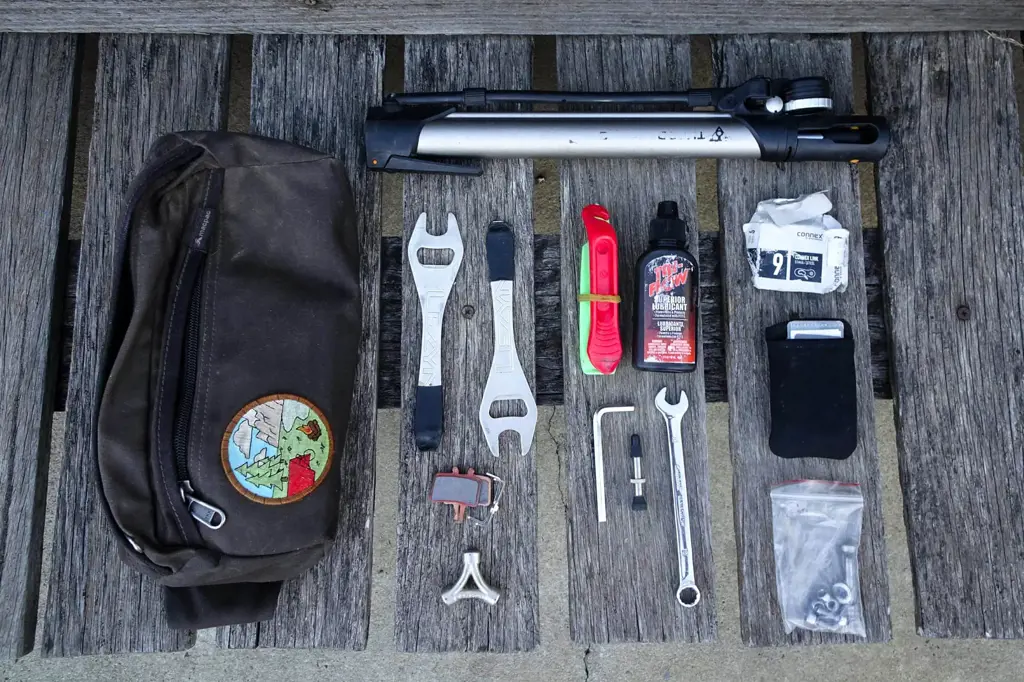
Bike commuting is a great way to incorporate exercise into your daily routine and reduce your carbon footprint. However, just like any form of transportation, it's important to be prepared for unexpected events or malfunctions that might occur while on the road. Having a well-equipped bike commute pack can save you time and frustration, and ensure a smooth ride to work or wherever you are headed.
There are several tools and repair items that should be included in a bike commute pack to help you handle common issues that may arise. These items can be easily carried in a saddlebag or backpack, and don't take up much space.
First and foremost, it is important to carry a spare inner tube and a tire patch kit. Flat tires are one of the most common issues cyclists face, and having a spare tube and patch kit will allow you to quickly fix the problem and continue on your way. It's also a good idea to carry tire levers, which will make it easier to remove the tire from the rim when replacing the inner tube.
A multi-tool is another essential item that should be included in your bike commute pack. These compact tools typically include a variety of hex wrenches, screwdrivers, and other tools that can be used to make adjustments or repairs on the go. A multi-tool is especially useful for adjusting brakes, derailleurs, and other components that may require occasional maintenance.
In addition to these basic repair items, it's a good idea to carry a small pump or CO2 inflator. These can be used to quickly inflate a flat tire or top off the pressure in your tires before heading out on your ride. It's also a good idea to carry a tire pressure gauge, as maintaining the correct tire pressure is important for both performance and preventing flats.
Other items that may come in handy include a chain tool, spare chain links or a quick-link, and a small bottle of chain lube. These can be used to repair a broken chain or perform routine maintenance to keep your drivetrain running smoothly.
Lastly, it's a good idea to carry a basic first aid kit. While biking is generally a safe and low-risk activity, accidents can happen. Having a first aid kit on hand can help you quickly treat minor injuries or provide assistance until further medical help arrives.
In summary, a well-equipped bike commute pack should include a spare inner tube, tire patch kit, tire levers, multi-tool, pump or CO2 inflator, tire pressure gauge, chain tool, spare chain links or quick-link, chain lube, and a basic first aid kit. By carrying these items, you can be prepared for common issues that may arise during your bike commute and ensure a smooth and enjoyable ride.
Essential Clothing Items to Pack for Alaska in September
You may want to see also

What are some tips for packing light for a bike commute without sacrificing necessary items?
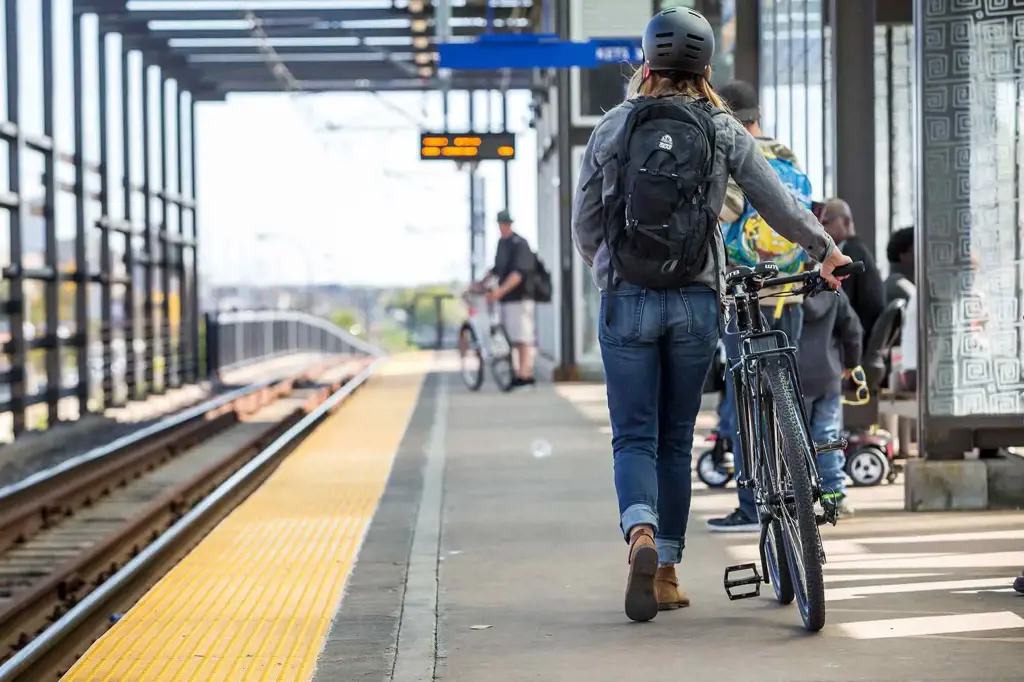
When it comes to bike commuting, it's important to find the right balance between comfort and convenience. Packing light is key, but you also want to make sure you have all the necessary items for a successful commute. Here are some tips to help you pack light for your bike commute without sacrificing anything you need.
- Choose the right bag: Invest in a good quality bike bag that is lightweight and has enough compartments to organize your belongings. Look for bags that are specifically designed for bike commuting, with features like rainproof material, reflective strips, and secure straps to keep the bag in place while riding.
- Prioritize the essentials: Make a list of the items you absolutely need for your commute. This typically includes personal identification, keys, smartphone, wallet, and any necessary work-related items like a laptop or documents. Keep in mind that you might also need to pack a change of clothes or toiletries depending on your workplace's dress code and facilities.
- Minimize clothing: Choose lightweight and versatile clothing options that can be easily layered. Opt for materials that are moisture-wicking, quick-drying, and wrinkle-resistant. If possible, bring a spare set of clothes to leave at your workplace, so you don't have to carry them back and forth every day.
- Streamline your toiletries: Rather than bringing full-size toiletry bottles, transfer your essentials like shampoo, body wash, and lotion into travel-sized containers. Consider using products that serve multiple purposes, such as a 2-in-1 shampoo and conditioner, or a face wash that can also be used as a body wash.
- Pack smart with multi-use items: Look for items that can serve multiple purposes to save space. For example, a bandana can be used as a face mask, headband, or even a towel in a pinch. A multitool can come in handy for minor bike repairs and also serves as a backup if you need to open a bottle or tighten screws.
- Get rid of unnecessary extras: Evaluate your commute routine and eliminate any excess items that you don't really need. Do you really need that extra pair of shoes or a bulky water bottle? Deciding what you can live without will help you pack lighter and more efficiently.
- Plan your meals: If you bring lunch or snacks with you, plan your meals in advance to prevent overpacking. Consider foods that are lightweight, easy to transport, and require minimal preparation. Opt for fruits, nuts, sandwiches, or salads that can be packed in reusable containers.
- Keep it organized: Use the compartments in your bag to keep your items organized and easily accessible. Categorize your belongings, such as putting all your electronics in one pocket, and your toiletries in another. This will help you locate what you need quickly and efficiently without needing to rummage through your entire bag.
In summary, packing light for a bike commute is all about careful planning and efficient organization. Prioritize your essentials, choose lightweight and multi-purpose items, and streamline your daily routine. With the right mindset and preparation, you can have a successful commute without sacrificing any necessary items.
Essential Items to Pack for Your Trip to LA
You may want to see also

Are there any safety equipment or gear that should be packed for a bike commute?
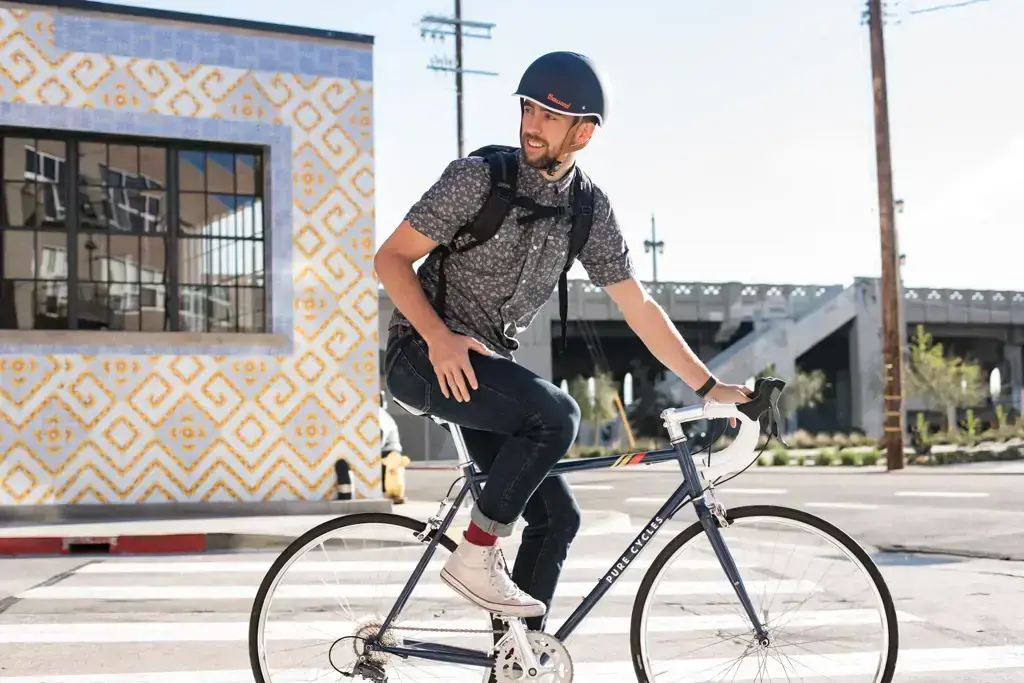
Bike commuting is a great way to reduce your carbon footprint, stay active, and avoid traffic. However, it's important to prioritize safety during your bike commute. Packing the right safety equipment and gear can make all the difference in ensuring a safe and enjoyable ride. In this article, we'll explore some essential safety equipment that you should pack for your bike commute.
- Helmet: The most important piece of safety equipment for any bike ride, a helmet should always be worn during your commute. Look for a helmet that meets safety standards and fits properly. Make sure to adjust the straps to secure it snugly on your head.
- Reflective clothing: Visibility is crucial when commuting by bike, especially during low-light conditions. Invest in reflective clothing, such as a high-visibility vest or jacket, to make yourself more visible to other road users. Reflective bands or stickers can also be attached to your bike for added visibility.
- Lights: Front and rear lights are essential for safe biking at night or during twilight hours. Choose lights that have a steady beam and are easily visible from a distance. It's recommended to use rechargeable lights or carry spare batteries to ensure they don't run out of power during your commute.
- Bike bell: A bike bell is a simple but effective tool to alert pedestrians and other cyclists of your presence. It can be particularly useful in busy urban areas or on shared paths. Use the bike bell to indicate your approach and pass with caution.
- Mirrors: Adding mirrors to your bike can significantly improve your awareness of surrounding traffic. Mirrors mounted on your handlebars or helmet give you a better view of what's behind you, eliminating the need to turn your head frequently.
- Backpack or panniers: Carrying your belongings in a backpack or panniers is not only more convenient but also safer. It keeps your hands free and reduces the risk of losing balance due to uneven weight distribution. Choose a backpack with reflective panels or attach reflective tape for added visibility.
- Bike lock: If you're planning to leave your bike unattended during your commute, a sturdy bike lock is a must-have. Look for a lock that is difficult to cut or break and always secure your bike to a fixed object, such as a bike rack or sturdy pole.
- First aid kit: Accidents can happen, even to the most cautious cyclists. Packing a small first aid kit with basic supplies, such as adhesive bandages, antiseptic wipes, and pain relievers, can come in handy in case of minor injuries.
Remember, safety should always be a top priority when commuting by bike. In addition to packing the right safety equipment, it's also important to follow traffic laws, signal your intentions, and stay alert to your surroundings. By taking these precautions, you can enjoy a safe and pleasant bike commute.
The Essential Tools for Starting a Cub Scout Pack
You may want to see also
Frequently asked questions
For your bike commute, it's important to have some essential items with you. For starters, always wear a helmet to protect your head in case of any accidents. Pack a water bottle to stay hydrated during your ride. It's also a good idea to have a small repair kit with tools, spare tires, and a pump in case you encounter any issues on the road. Lastly, bring a lock to secure your bike when you reach your destination.
Yes, packing a change of clothes is recommended for your bike commute. Depending on the distance and intensity of your ride, you may sweat and feel the need to freshen up when you arrive. Packing a clean set of clothes will help you feel more comfortable and ready for the day ahead. You can also consider packing wet wipes or a small towel to wipe off any sweat accumulated during the ride.
There are a few options for packing your belongings during a bike commute. One option is to use panniers or saddlebags that attach to your bike. These provide storage space for your essentials and distribute the weight evenly on your bike. Another option is to use a backpack or messenger bag. Make sure the backpack is lightweight and comfortable to carry, and that it has compartments to keep your items organized. Whichever method you choose, make sure the weight is balanced and doesn't affect your balance while cycling.
Yes, it's highly recommended to pack a bike lock for your commute. When you reach your destination, whether it's the office, a café, or a store, you'll need to secure your bike to prevent theft. Look for a reliable and sturdy lock that is difficult to break. U-locks and chain locks are popular choices. Don't forget to lock both your bike frame and wheels to a secure object, such as a bike rack or post.
Yes, a few safety items should be part of your bike commute pack. Besides wearing a helmet, it's a good idea to bring a front and rear light for visibility, especially if you'll be cycling during dawn, dusk, or at night. Reflective gear, such as a vest or ankle bands, can also increase your visibility to motorists. Consider packing a portable bike pump and patch kit in case of a flat tire. Additionally, carrying a small first aid kit with band-aids, antiseptic wipes, and pain relievers is always a good precaution.







